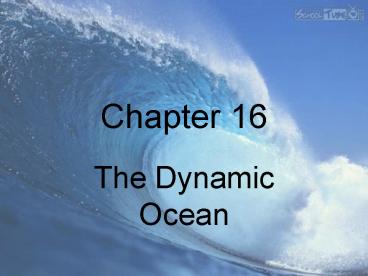The Dynamic Ocean PowerPoint PPT Presentation
1 / 19
Title: The Dynamic Ocean
1
Chapter 16
- The Dynamic Ocean
2
Section 16.1
- Ocean Circulation
3
16.1 The Composition of Seawater
Surface Circulation
? Ocean current is the mass of ocean water that
flows from one place to another.
? Surface Currents
Surface currents are movements of water that
flow horizontally in the upper part of the
oceans surface.
Surface currents develop from friction between
the ocean and the wind that blows across its
surface.
4
Ocean Surface Currents
5
16.1 The Composition of Seawater
Surface Circulation
? Gyres
Gyres are huge circular-moving current systems
that dominate the surfaces of the oceans.
The Coriolis effect is the deflection of
currents away from their original course as a
result of Earths rotation.
6
16.1 The Composition of Seawater
Surface Circulation
? Ocean Currents and Climate
When currents from low-latitude regions move
into higher latitudes, they transfer heat from
warmer to cooler areas on Earth.
As cold water currents travel toward the
equator, they help moderate the warm temperatures
of adjacent land areas.
7
False-Colored Satellite Image of the Gulf Stream
8
What causes ocean surface currents?
- Gravitational attraction
- Friction between the ocean and wind on its
surface - Ocean movements associated with earthquakes
- Changes in water density
9
Currents affect climate by
- Making ocean water evaporate
- Transferring heat and cold between the tropics
and polar regions - Changing the density of water in the tropics
- Transferring heat from the polar regions to the
tropics
10
16.1 The Composition of Seawater
Surface Circulation
? Upwelling
Upwelling is the rise of cold water from
deeper layers to replace warmer surface water.
Upwelling brings greater concentrations of
dissolved nutrients, such as nitrates and
phosphates, to the ocean surface.
11
Effects of Upwelling
12
16.1 The Composition of Seawater
Deep-Ocean Circulation
? Density Currents
Density currents are vertical currents of
ocean water that result from density differences
among water masses.
An increase in seawater density can be caused
by a decrease in temperature or an increase in
salinity.
13
What is the importance of upwelling?
- It brings warm water from the tropics to the
poles. - It decreases winds along exposed coastlines.
- It helps warm the North Atlantic gyre.
- It brings dissolved nutrients to the oceans
surface.
14
A decrease in seawater temperature or an increase
in salinity causes
- Upwelling along tropical coast.
- An increase in seawater density.
- The circulation of ocean gyres.
- A decrease in seawater density.
15
16.1 The Composition of Seawater
Deep-Ocean Circulation
? High Latitudes
Most water involved in deep-ocean currents
begins in high latitudes at the surface.
? Evaporation
- Density currents can also result from
increased salinity of ocean water due to
evaporation. - Example The Mediterranean Sea
16
16.1 The Composition of Seawater
Deep-Ocean Circulation
? A Conveyor Belt
In a simplified model, ocean circulation is
similar to a conveyor belt that travels from the
Atlantic Ocean, through the Indian and Pacific
Oceans, and back again.
17
Conveyor Belt Model
18
Cross Section of the Arctic Ocean
19
What causes density currents to form in the
Mediterranean Sea?
- Freezing
- Evaporation
- Melting Ice
- Upwelling

